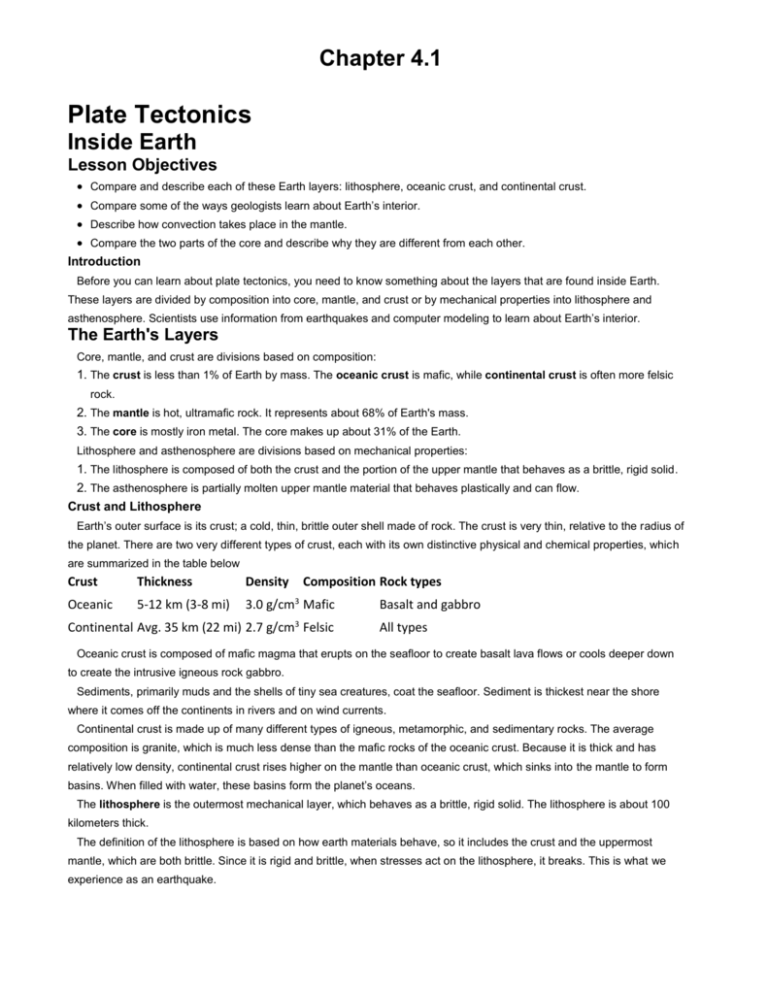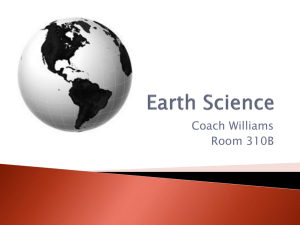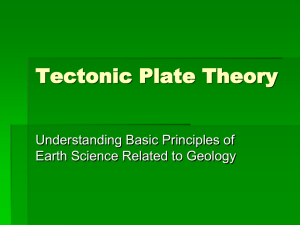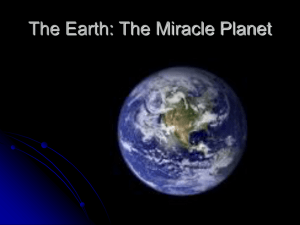Theory of Plate Tectonics
advertisement

Chapter 4.1 Plate Tectonics Inside Earth Lesson Objectives Compare and describe each of these Earth layers: lithosphere, oceanic crust, and continental crust. Compare some of the ways geologists learn about Earth’s interior. Describe how convection takes place in the mantle. Compare the two parts of the core and describe why they are different from each other. Introduction Before you can learn about plate tectonics, you need to know something about the layers that are found inside Earth. These layers are divided by composition into core, mantle, and crust or by mechanical properties into lithosphere and asthenosphere. Scientists use information from earthquakes and computer modeling to learn about Earth’s interior. The Earth's Layers Core, mantle, and crust are divisions based on composition: 1. The crust is less than 1% of Earth by mass. The oceanic crust is mafic, while continental crust is often more felsic rock. 2. The mantle is hot, ultramafic rock. It represents about 68% of Earth's mass. 3. The core is mostly iron metal. The core makes up about 31% of the Earth. Lithosphere and asthenosphere are divisions based on mechanical properties: 1. The lithosphere is composed of both the crust and the portion of the upper mantle that behaves as a brittle, rigid solid. 2. The asthenosphere is partially molten upper mantle material that behaves plastically and can flow. Crust and Lithosphere Earth’s outer surface is its crust; a cold, thin, brittle outer shell made of rock. The crust is very thin, relative to the radius of the planet. There are two very different types of crust, each with its own distinctive physical and chemical properties, which are summarized in the table below Crust Thickness Density Composition Rock types Oceanic 5-12 km (3-8 mi) 3.0 g/cm3 Mafic 3 Continental Avg. 35 km (22 mi) 2.7 g/cm Felsic Basalt and gabbro All types Oceanic crust is composed of mafic magma that erupts on the seafloor to create basalt lava flows or cools deeper down to create the intrusive igneous rock gabbro. Sediments, primarily muds and the shells of tiny sea creatures, coat the seafloor. Sediment is thickest near the shore where it comes off the continents in rivers and on wind currents. Continental crust is made up of many different types of igneous, metamorphic, and sedimentary rocks. The average composition is granite, which is much less dense than the mafic rocks of the oceanic crust. Because it is thick and has relatively low density, continental crust rises higher on the mantle than oceanic crust, which sinks into the mantle to form basins. When filled with water, these basins form the planet’s oceans. The lithosphere is the outermost mechanical layer, which behaves as a brittle, rigid solid. The lithosphere is about 100 kilometers thick. The definition of the lithosphere is based on how earth materials behave, so it includes the crust and the uppermost mantle, which are both brittle. Since it is rigid and brittle, when stresses act on the lithosphere, it breaks. This is what we experience as an earthquake. Mantle The two most important things about the mantle are: (1) it is made of solid rock, and (2) it is hot. Scientists know that the mantle is made of rock based on evidence from seismic waves, heat flow, and meteorites. The properties fit the ultramafic rock peridotite, which is made of the iron- and magnesium-rich silicate minerals. Peridotite is rarely found at Earth's surface. Scientists know that the mantle is extremely hot because of the heat flowing outward from it and because of its physical properties. Heat flows in two different ways within the Earth: Conduction: Heat is transferred through rapid collisions of atoms, which can only happen if the material is solid. Heat flows from warmer to cooler places until all are the same temperature. The mantle is hot mostly because of heat conducted from the core. Convection: If a material is able to move, even if it moves very slowly, convection currents can form. Convection in the mantle is the same as convection in a pot of water on a stove. Convection currents within Earth's mantle form as material near the core heats up. As the core heats the bottom layer of mantle material, particles move more rapidly, decreasing its density and causing it to rise. The rising material begins the convection current. When the warm material reaches the surface, it spreads horizontally. The material cools because it is no longer near the core. It eventually becomes cool and dense enough to sink back down into the mantle. At the bottom of the mantle, the material travels horizontally and is heated by the core. It reaches the location where warm mantle material rises, and the mantle convection cell is complete. Core At the planet’s center lies a dense metallic core. Scientists know that the core is metal because: The density of Earth's surface layers is much less than the overall density of the planet, as calculated from the planet’s rotation. If the surface layers are less dense than average, then the interior must be denser than average. Calculations indicate that the core is about 85% iron metal with nickel metal making up much of the remaining 15%. Metallic meteorites are thought to be representative of the core. The 85% iron/15% nickel calculation above is also seen in metallic meteorites. If Earth's core were not metal, the planet would not have a magnetic field. Metals such as iron are magnetic, but rock, which makes up the mantle and crust, is not. Scientists know that the outer core is liquid and the inner core is solid because: S-waves stop at the inner core. The strong magnetic field is caused by convection in the liquid outer core. Convection currents in the outer core are due to heat from the even hotter inner core. The heat that keeps the outer core from solidifying is produced by the breakdown of radioactive elements in the inner core. Continental Drift Lesson Objectives Explain the continental drift hypothesis. Describe the evidence Wegener used to support his continental drift idea. Describe later evidence for continental drift. Introduction The continental drift hypothesis was developed in the early part of the 20 th century, mostly by Alfred Wegener. Wegener said that continents move around on Earth’s surface and that they were once joined together as a single supercontinent. While Wegener was alive, scientists did not believe that the continents could move. The Continental Drift Idea Find a map of the continents and cut each one out. Better yet, use a map where the edges of the continents show the continental shelf. That’s the true size and shape of a continent. Can you fit the pieces together? The easiest link is between the eastern Americas and western Africa and Europe, but the rest can fit together too. Alfred Wegener proposed that the continents were once united into a single supercontinent named Pangaea, meaning all earth in ancient Greek. He suggested that Pangaea broke up long ago and that the continents then moved to their current positions. He called his hypothesis continental drift. Evidence for Continental Drift Besides the way the continents fit together, Wegener and his supporters collected a great deal of evidence for the continental drift hypothesis. Identical rocks, of the same type and age, are found on both sides of the Atlantic Ocean. Wegener said the rocks had formed side-by-side and that the land had since moved apart. Mountain ranges with the same rock types, structures, and ages are now on opposite sides of the Atlantic Ocean. The Appalachians of the eastern United States and Canada, for example, are just like mountain ranges in eastern Greenland, Ireland, Great Britain, and Norway. Wegener concluded that they formed as a single mountain range that was separated as the continents drifted. Ancient fossils of the same species of extinct plants and animals are found in rocks of the same age but are on continents that are now widely separated. Wegener proposed that the organisms had lived side by side, but that the lands had moved apart after they were dead and fossilized. He suggested that the organisms would not have been able to travel across the oceans. o Fossils of the seed fern Glossopteris were too heavy to be carried so far by wind. o Mesosaurus was a swimming reptile but could only swim in fresh water. o Cynognathus and Lystrosaurus were land reptiles and were unable to swim. Grooves and rock deposits left by ancient glaciers are found today on different continents very close to the equator. This would indicate that the glaciers either formed in the middle of the ocean and/or covered most of the Earth. Today glaciers only form on land and nearer the poles. Wegener thought that the glaciers were centered over the southern land mass close to the South Pole and the continents moved to their present positions later on. Coral reefs and coal-forming swamps are found in tropical and subtropical environments, but ancient coal seams and coral reefs are found in locations where it is much too cold today. Wegener suggested that these creatures were alive in warm climate zones and that the fossils and coal later had drifted to new locations on the continents. Although Wegener’s evidence was sound, most geologists at the time rejected his hypothesis of continental drift. Why do you think they did not accept continental drift? Scientists argued that there was no way to explain how solid continents could plow through solid oceanic crust. Wegener’s idea was nearly forgotten until technological advances presented even more evidence that the continents moved and gave scientists the tools to develop a mechanism for Wegener’s drifting continents. Magnetic Polarity Evidence Puzzling new evidence came in the 1950s from studies on the Earth's magnetic history. Scientists used magnetometers, devices capable of measuring the magnetic field intensity, to look at the magnetic properties of rocks in many locations. Magnetite crystals are like tiny magnets that point to the north magnetic pole as they crystallize from magma. The crystals record both the direction and strength of the magnetic field at the time. The direction is known as the field’s magnetic polarity. Magnetic Polarity on the Same Continent with Rocks of Different Ages Geologists noted important things about the magnetic polarity of different aged rocks on the same continent: Magnetite crystals in fresh volcanic rocks point to the current magnetic north pole no matter what continent or where on the continent the rocks are located. Older rocks that are the same age and are located on the same continent point to the same location, but that location is not the current north magnetic pole. Older rocks that are of different ages do not point to the same locations or to the current magnetic north pole. In other words, although the magnetite crystals were pointing to the magnetic north pole, the location of the pole seemed to wander. Scientists were amazed to find that the north magnetic pole changed location through time. There are three possible explanations for this: 1. The continents remained fixed and the north magnetic pole moved. 2. The north magnetic pole stood still and the continents moved. 3. Both the continents and the north pole moved. Magnetic Polarity on Different Continents with Rocks of the Same Age Geologists noted that for rocks of the same age but on different continents, the little magnets pointed to different magnetic north poles. 400-million-year-old magnetite in Europe pointed to a different north magnetic pole than the same-aged magnetite in North America. 250 million years ago, the north poles were also different for the two continents. The scientists looked again at the three possible explanations. Only one can be correct. If the continents had remained fixed while the north magnetic pole moved, there must have been two separate north poles. Since there is only one north pole today, the only reasonable explanation is that the north magnetic pole has remained fixed but that the continents have moved. To test this, geologists fitted the continents together as Wegener had done. It worked! There has only been one magnetic north pole and the continents have drifted. They named the phenomenon of the magnetic pole that seemed to move but actually did not apparent polar wander. This evidence for continental drift gave geologists renewed interest in understanding how continents could move about on the planet’s surface. Chapter 4.2 Seafloor Spreading Lesson Objectives Describe the main features of the seafloor. Explain what seafloor magnetism tells scientists about the seafloor. Describe the process of seafloor spreading. Introduction World War II gave scientists the tools to find the mechanism for continental drift that had eluded Wegener. Maps and other data gathered during the war allowed scientists to develop the seafloor spreading hypothesis. This hypothesis traces oceanic crust from its origin at a mid-ocean ridge to its destruction at a deep sea trench and is the mechanism for continental drift. Seafloor Bathymetry During World War II, battleships and submarines carried echo sounders to locate enemy submarines. Echo sounders produce sound waves that travel outward in all directions, bounce off the nearest object, and then return to the ship. By knowing the speed of sound in seawater, scientists calculate the distance to the object based on the time it takes for the wave to make a round-trip. During the war, most of the sound waves ricocheted off the ocean bottom. After the war, scientists pieced together the ocean depths to produce bathymetric maps, which reveal the features of the ocean floor as if the water were taken away. Even scientist were amazed that the seafloor was not completely flat. The major features of the ocean basins include: mid-ocean ridges: rise up high above the deep seafloor as a long chain of mountains deep sea trenches: found at the edges of continents or in the sea near chains of active volcanoes abyssal plains: flat areas, although many are dotted with volcanic mountains When they first observed these bathymetric maps, scientists wondered what had formed these features. Seafloor Magnetism Sometimes -- no one really knows why -- the magnetic poles switch positions. North becomes south and south becomes north. Normal polarity: north and south poles are aligned as they are now. Reversed polarity: north and south poles are in the opposite position. During WWII, magnetometers attached to ships to search for submarines located an astonishing feature: the normal and reversed magnetic polarity of seafloor basalts creates a pattern. Stripes of normal polarity and reversed polarity alternate across the ocean bottom. Stripes form mirror images on either side of the mid-ocean ridges. Stripes end abruptly at the edges of continents, sometimes at a deep sea trench. The characteristics of the rocks and sediments change with distance from the ridge axis as seen in the table below. At ridge axis Rock ages Sediment thickness Crust thickness Heat flow youngest none With distance from axis becomes older becomes thicker thinnest hottest becomes thicker becomes cooler The oldest seafloor is near the edges of continents or deep sea trenches and is less than 180 million years old. Since the oldest ocean crust is so much younger than the oldest continental crust, scientists realized that seafloor was being destroyed in a relatively short time. The Seafloor Spreading Hypothesis Scientists brought these observations together in the early 1960s to create the seafloor spreading hypothesis. In this hypothesis, hot buoyant mantle rises up a mid-ocean ridge, causing the ridge to rise upward. The hot magma at the ridge erupts as lava that forms new seafloor. When the lava cools, the magnetite crystals take on the current magnetic polarity. As more lava erupts, it pushes the seafloor horizontally away from ridge axis. The magnetic stripes continue across the seafloor. As oceanic crust forms and spreads, moving away from the ridge crest, it pushes the continent away from the ridge axis. If the oceanic crust reaches a deep sea trench, it sinks into the trench and is lost into the mantle. The oldest crust is coldest and lies deepest in the ocean because it is less buoyant than the hot new crust. Seafloor spreading is the mechanism for Wegener’s drifting continents. Convection currents within the mantle take the continents on a conveyor-belt ride of oceanic crust that over millions of years takes them around the planet’s surface. Theory of Plate Tectonics Lesson Objectives Describe what a plate is and how scientists can recognize its edges. Explain how mantle convection moves lithospheric plates. List the three types of boundaries. Are they prone to earthquakes or volcanoes? Describe how plate tectonics processes lead to changes in Earth’s surface features. Introduction When the concept of seafloor spreading came along, scientists recognized that it was the mechanism to explain how continents could move around Earth’s surface. Like the scientists before us, we will now merge the ideas of continental drift and seafloor spreading into the theory of plate tectonics. Earth’s Tectonic Plates Seafloor and continents move around on Earth’s surface, but what is actually moving? What portion of the Earth makes up the “plates” in plate tectonics? This question was also answered because of technology developed during war times - in this case, the Cold War. The plates are made up of the lithosphere. During the 1950s and early 1960s, scientists set up seismograph networks to see if enemy nations were testing atomic bombs. These seismographs also recorded all of the earthquakes around the planet. The seismic records could be used to locate an earthquake’s epicenter, the point on Earth’s surface directly above the place where the earthquake occurs. Earthquake epicenters outline the plates. Mid-ocean ridges, trenches, and large faults mark the edges of the plates, and this is where earthquakes occur. The lithosphere is divided into a dozen major and several minor plates. The plates’ edges can be drawn by connecting the dots that mark earthquakes' epicenters. A single plate can be made of all oceanic lithosphere or all continental lithosphere, but nearly all plates are made of a combination of both. Movement of the plates over Earth's surface is termed plate tectonics. Plates move at a rate of a few centimeters a year, about the same rate fingernails grow. How Plates Move If seafloor spreading drives the plates, what drives seafloor spreading? Picture two convection cells side-by-side in the mantle. 1. Hot mantle from the two adjacent cells rises at the ridge axis, creating new ocean crust. 2. The top limb of the convection cell moves horizontally away from the ridge crest, as does the new seafloor. 3. The outer limbs of the convection cells plunge down into the deeper mantle, dragging oceanic crust as well. This takes place at the deep sea trenches. 4. The material sinks to the core and moves horizontally. 5. The material heats up and reaches the zone where it rises again. Plate Boundaries Plate boundaries are the edges where two plates meet. Most geologic activities, including volcanoes, earthquakes, and mountain building, take place at plate boundaries. How can two plates move relative to each other? Divergent plate boundaries: the two plates move away from each other. Convergent plate boundaries: the two plates move towards each other. Transform plate boundaries: the two plates slip past each other. The type of plate boundary and the type of crust found on each side of the boundary determines what sort of geologic activity will be found there. Divergent Plate Boundaries Plates move apart at mid-ocean ridges where new seafloor forms. Between the two plates is a rift valley. Lava flows at the surface cool rapidly to become basalt, but deeper in the crust, magma cools more slowly to form gabbro. So the entire ridge system is made up of igneous rock that is either extrusive or intrusive. Earthquakes are common at mid-ocean ridges since the movement of magma and oceanic crust results in crustal shaking. The vast majority of mid-ocean ridges are located deep below the sea. Can divergent plate boundaries occur within a continent? What is the result? In continental rifting, magma rises beneath the continent, causing it to become thinner, break, and ultimately split apart. New ocean crust erupts in the void, creating an ocean between continents. Convergent Plate Boundaries When two plates converge, the result depends on the type of lithosphere the plates are made of. No matter what, smashing two enormous slabs of lithosphere together results in magma generation and earthquakes. Ocean-continent: When oceanic crust converges with continental crust, the denser oceanic plate plunges beneath the continental plate. This process, called subduction, occurs at the oceanic trenches. The entire region is known as a subduction zone. Subduction zones have a lot of intense earthquakes and volcanic eruptions. The subducting plate causes melting in the mantle. The magma rises and erupts, creating volcanoes. These coastal volcanic mountains are found in a line above the subducting plate. The volcanoes are known as a continental arc. The volcanoes of northeastern California—Lassen Peak, Mount Shasta, and Medicine Lake volcano—along with the rest of the Cascade Mountains of the Pacific Northwest are the result of subduction of the Juan de Fuca plate beneath the North American plate. The Juan de Fuca plate is created by seafloor spreading just offshore at the Juan de Fuca ridge. If the magma at a continental arc is felsic, it may be too viscous (thick) to rise through the crust. The magma will cool slowly to form granite or granodiorite. These large bodies of intrusive igneous rocks are called batholiths, which may someday be uplifted to form a mountain range. Ocean-ocean: When two oceanic plates converge, the older, denser plate will subduct into the mantle. An ocean trench marks the location where the plate is pushed down into the mantle. The line of volcanoes that grows on the upper oceanic plate is an island arc. Do you think earthquakes are common in these regions? Continent-continent: Continental plates are too buoyant to subduct. What happens to continental material when it collides? Since it has nowhere to go but up, this creates some of the world’s largest mountains ranges (Figure 1.33 below). Magma cannot penetrate this thick crust so there are no volcanoes, although the magma stays in the crust. Metamorphic rocks are common because of the stress the continental crust experiences. With enormous slabs of crust smashing together, continent-continent collisions bring on numerous and large earthquakes. The Appalachian Mountains are the remnants of a large mountain range that was created when North America rammed into Eurasia about 250 million years ago. Transform Plate Boundaries Transform plate boundaries are seen as transform faults, where two plates move past each other in opposite directions. Transform faults on continents bring massive earthquakes. California is very geologically active. What are the three major plate boundaries in or near California? 1. A transform plate boundary between the Pacific and North American plates creates the San Andreas Fault, the world’s most notorious transform fault. 2. Just offshore, a divergent plate boundary, Juan de Fuca ridge, creates the Juan de Fuca plate. 3. A convergent plate boundary between the Juan de Fuca oceanic plate and the North American continental plate creates the Cascades volcanoes. Earth’s Changing Surface Geologists know that Wegener was right because the movements of continents explain so much about the geology we see. Most of the geologic activity that we see on the planet today is because of the interactions of the moving plates. Before Pangaea came together, the continents were separated by an ocean where the Atlantic is now. The proto-Atlantic ocean shrank as the Pacific Ocean grew. Currently, the Pacific is shrinking as the Atlantic is growing. This supercontinent cycle is responsible for most of the geologic features that we see and many more that are long gone. Intraplate Activity A small amount of geologic activity, known as intraplate activity, does not take place at plate boundaries but within a plate instead. Mantle plumes are pipes of hot rock that rise through the mantle. The release of pressure causes melting near the surface to form a hotspot. Eruptions at the hotspot create a volcano. Hotspot volcanoes are found in a line. Can you figure out why? Hint: The youngest volcano sits above the hotspot and volcanoes become older with distance from the hotspot. Geologists use some hotspot chains to tell the direction and the speed a plate is moving. Hotspot magmas rarely penetrate through thick continental crust. One exception is the Yellowstone hotspot. Plate Tectonics Theory Plate tectonics is the unifying theory of geology. Plate tectonics theory explains why: Earth's geography has changed through time and continues to change today. some places are prone to earthquakes while others are not. certain regions may have deadly, mild, or no volcanic eruptions. mountain ranges are located where they are. Plate tectonic motions affect Earth’s rock cycle, climate, and the evolution of life.









